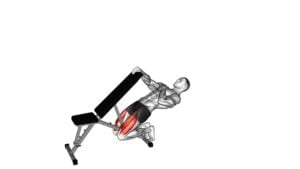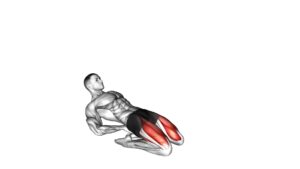Weighted Sissy Squat – Video Exercise Guide & Tips

Are you looking for an effective lower body exercise that targets your quads, glutes, and core? Look no further than the weighted sissy squat!
Watch This Exercise Video
In this video exercise guide, we'll show you the proper form and technique for this challenging move. You'll also learn how to choose the right weight and avoid common mistakes.
With variations and progressions included, you'll be able to take your sissy squat game to the next level.
Let's get started!
Key Takeaways
- Targets multiple muscles in the lower body
- Effective addition to any leg workout
- Increases intensity by adding weights
- Improves lower body strength and stability
Benefits of the Weighted Sissy Squat
Discover the advantages of incorporating weighted sissy squats into your workout routine. This exercise targets multiple muscles in your lower body, making it an effective addition to any leg workout. The main muscles targeted during the weighted sissy squat include the quadriceps, hamstrings, and glutes. By loading the exercise with weights, you can increase the intensity and challenge your muscles even further.
To incorporate the weighted sissy squat into your workout routine, start by positioning yourself in front of a sturdy support, such as a squat rack or a wall-mounted bar. Place your feet shoulder-width apart and slightly angled outward. Hold a dumbbell or a weight plate against your chest, keeping your elbows tucked in. Slowly lower your body by bending at the knees, while keeping your heels on the ground and your torso upright. Once your thighs are parallel to the ground, push through your heels to return to the starting position.
Incorporating weighted sissy squats into your leg workout can help improve lower body strength and stability. It also enhances muscle endurance and can contribute to better overall athletic performance.
Now that you understand the benefits of this exercise, let's move on to the next section, which will focus on proper form and technique for the weighted sissy squat.
Proper Form and Technique for the Weighted Sissy Squat
To perform the weighted sissy squat with proper form and technique, position yourself in front of a sturdy support and place your feet shoulder-width apart and slightly angled outward. This will help to maintain stability and balance throughout the exercise.
Here are some key points to keep in mind for proper technique:
- Keep your core engaged and maintain a straight posture throughout the movement.
- Slowly lower your body by bending at the knees and ankles, while keeping your heels on the ground and your torso upright.
- Descend until your thighs are parallel to the ground or as low as you can comfortably go.
- Push through your heels to return to the starting position, fully extending your knees and hips.
- Avoid leaning forward or allowing your knees to cave inwards, as these are common mistakes that can put unnecessary strain on your joints.
Choosing the Right Weight for the Weighted Sissy Squat
Once you have mastered the proper form and technique for the weighted sissy squat, it's important to choose the right weight for your training.
The goal is to gradually increase the load over time to promote progressive overload and continued muscle growth. Dumbbells are a great option for adding weight to the exercise.
Start with a weight that challenges you but still allows you to maintain proper form throughout the movement. Aim for a weight that allows you to perform 8-12 reps with good control and without compromising your technique.
If you find that the weight is too light, it's time to increase the load. On the other hand, if the weight is too heavy and you're unable to complete the desired number of reps with proper form, reduce the weight until you can perform the exercise correctly.
Remember, the focus should be on quality over quantity.
In the next section, we'll discuss common mistakes to avoid during the weighted sissy squat, so you can maximize your results and minimize the risk of injury.
Common Mistakes to Avoid During the Weighted Sissy Squat
To ensure optimal results and minimize the risk of injury, it's crucial to avoid common mistakes during the weighted sissy squat. Here are some common mistakes and their corrections to help you perform the exercise correctly:
- Mistake: Leaning too far forward
- Correction: Keep your torso upright and engage your core to maintain balance and stability.
- Mistake: Using excessive weight
- Correction: Start with a lighter weight and gradually increase as your strength improves to avoid strain and injury.
- Mistake: Allowing the knees to cave inwards
- Correction: Push your knees outwards throughout the movement to engage your glutes and protect your knee joints.
- Mistake: Rounding the lower back
- Correction: Maintain a neutral spine by engaging your core and keeping your back straight throughout the exercise.
- Mistake: Performing the exercise too quickly
- Correction: Slow down the movement and focus on proper form and control to maximize muscle activation and prevent jerky motions.
Variations and Progressions of the Weighted Sissy Squat
Now, let's delve into the variations and progressions of the weighted sissy squat to further challenge and strengthen your lower body muscles.
When it comes to advanced modifications of the weighted sissy squat, there are a few options you can consider.
One option is to increase the weight you're using. This can be done by using a weighted vest, holding a dumbbell or kettlebell against your chest, or even using a barbell on your back. By adding additional weight, you'll increase the intensity of the exercise and stimulate further muscle growth.
Another advanced modification is to elevate your heels during the squat. This can be done by placing a small weight plate or block under your heels. This variation places more emphasis on the quads and can help target them more effectively.
In terms of equipment options, the weighted sissy squat can be performed with a variety of tools. You can use a sissy squat machine, which is specifically designed for this exercise and provides stability and support. Alternatively, you can use a Smith machine or a squat rack with safety bars to hold onto while performing the exercise.
Frequently Asked Questions
How Many Calories Does the Weighted Sissy Squat Burn?
When it comes to the weighted sissy squat, one common question is how many calories it burns. While discussing this exercise without the specific context of the Weighted Sissy Squat – Video Exercise Guide & Tips {085112}, it's important to note that the number of calories burned during any exercise can vary depending on factors like weight, intensity, and duration.
However, it's worth mentioning that the weighted sissy squat is a compound movement that engages multiple muscle groups, making it an effective exercise for overall strength and muscle development.
Can the Weighted Sissy Squat Help With Knee Rehabilitation?
The weighted sissy squat can be beneficial for knee rehabilitation. It helps strengthen the muscles around the knee, improving stability and reducing the risk of injury.
Additionally, it can be used as an alternative to traditional squats for those with knee issues.
The weighted sissy squat also promotes muscle growth in the quads, hamstrings, and glutes, making it an effective exercise for overall lower body strength.
Is It Safe to Perform the Weighted Sissy Squat if I Have a Previous Knee Injury?
If you have a previous knee injury, it's important to prioritize safety when performing the weighted sissy squat. Consider alternatives that are less stressful on your knees, such as leg press or step-ups.
If you still want to do the weighted sissy squat, make sure to use proper form and start with lighter weights. Engage your core, keep your back straight, and avoid letting your knees go past your toes.
Listen to your body and stop if you experience any pain or discomfort.
How Often Should I Incorporate the Weighted Sissy Squat Into My Workout Routine?
To maximize the benefits of the weighted sissy squat, it's important to incorporate it into your workout routine regularly. The frequency of performing this exercise will depend on your fitness goals and current fitness level.
However, as a general guideline, it's recommended to include the weighted sissy squat 2-3 times per week. This will help strengthen your quadriceps, improve knee stability, and enhance overall lower body strength.
Remember to start with lighter weights and gradually increase as you gain strength and comfort.
Can the Weighted Sissy Squat Help Improve My Vertical Jump?
The weighted sissy squat can definitely help improve your vertical jump. By incorporating this exercise into your routine, you can strengthen your quadriceps, hamstrings, and glutes, which are all important muscle groups for explosive jumping power.
The weighted sissy squat benefits also include improving your balance, stability, and overall lower body strength. There are also variations of the exercise that you can try to target different muscle groups and add variety to your workouts.
Conclusion
In conclusion, the weighted sissy squat is a highly effective exercise for strengthening the quadriceps and improving lower body stability. By utilizing proper form and technique, choosing the appropriate weight, and avoiding common mistakes, you can maximize the benefits of this exercise.
Additionally, there are several variations and progressions available to challenge yourself as you become more proficient.
Incorporate the weighted sissy squat into your workout routine to achieve stronger, more defined legs.

Author
Years ago, the spark of my life’s passion ignited in my mind the moment I stepped into the local gym for the first time. The inaugural bead of perspiration, the initial endeavor, the very first surge of endorphins, and a sense of pride that washed over me post-workout marked the beginning of my deep-seated interest in strength sports, fitness, and sports nutrition. This very curiosity blossomed rapidly into a profound fascination, propelling me to earn a Master’s degree in Physical Education from the Academy of Physical Education in Krakow, followed by a Sports Manager diploma from the Jagiellonian University. My journey of growth led me to gain more specialized qualifications, such as being a certified personal trainer with a focus on sports dietetics, a lifeguard, and an instructor for wellness and corrective gymnastics. Theoretical knowledge paired seamlessly with practical experience, reinforcing my belief that the transformation of individuals under my guidance was also a reflection of my personal growth. This belief holds true even today. Each day, I strive to push the boundaries and explore new realms. These realms gently elevate me to greater heights. The unique combination of passion for my field and the continuous quest for growth fuels my drive to break new ground.







